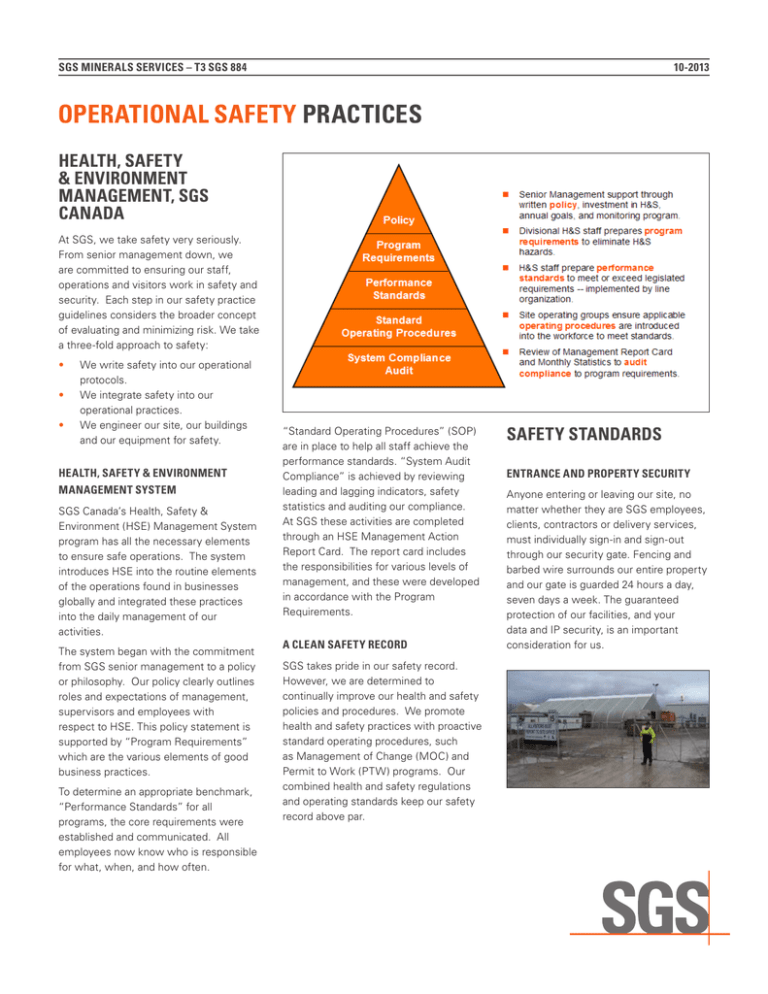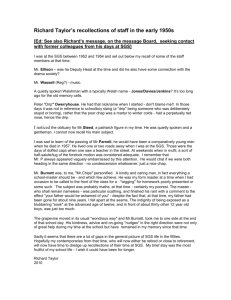
SGS MINERALS SERVICES – T3 SGS 884
10-2013
OPERATIONAL SAFETY PRACTICES
HEALTH, SAFETY
& ENVIRONMENT
MANAGEMENT, SGS
CANADA
At SGS, we take safety very seriously.
From senior management down, we
are committed to ensuring our staff,
operations and visitors work in safety and
security. Each step in our safety practice
guidelines considers the broader concept
of evaluating and minimizing risk. We take
a three-fold approach to safety:
••
••
••
We write safety into our operational
protocols.
We integrate safety into our
operational practices.
We engineer our site, our buildings
and our equipment for safety.
HEALTH, SAFETY & ENVIRONMENT
MANAGEMENT SYSTEM
SGS Canada’s Health, Safety &
Environment (HSE) Management System
program has all the necessary elements
to ensure safe operations. The system
introduces HSE into the routine elements
of the operations found in businesses
globally and integrated these practices
into the daily management of our
activities.
The system began with the commitment
from SGS senior management to a policy
or philosophy. Our policy clearly outlines
roles and expectations of management,
supervisors and employees with
respect to HSE. This policy statement is
supported by “Program Requirements”
which are the various elements of good
business practices.
To determine an appropriate benchmark,
“Performance Standards” for all
programs, the core requirements were
established and communicated. All
employees now know who is responsible
for what, when, and how often.
“Standard Operating Procedures” (SOP)
are in place to help all staff achieve the
performance standards. “System Audit
Compliance” is achieved by reviewing
leading and lagging indicators, safety
statistics and auditing our compliance.
At SGS these activities are completed
through an HSE Management Action
Report Card. The report card includes
the responsibilities for various levels of
management, and these were developed
in accordance with the Program
Requirements.
A CLEAN SAFETY RECORD
SGS takes pride in our safety record.
However, we are determined to
continually improve our health and safety
policies and procedures. We promote
health and safety practices with proactive
standard operating procedures, such
as Management of Change (MOC) and
Permit to Work (PTW) programs. Our
combined health and safety regulations
and operating standards keep our safety
record above par.
SAFETY STANDARDS
ENTRANCE AND PROPERTY SECURITY
Anyone entering or leaving our site, no
matter whether they are SGS employees,
clients, contractors or delivery services,
must individually sign-in and sign-out
through our security gate. Fencing and
barbed wire surrounds our entire property
and our gate is guarded 24 hours a day,
seven days a week. The guaranteed
protection of our facilities, and your
data and IP security, is an important
consideration for us.
SGS MINERALS SERVICES – T3 SGS 884
SITE ORIENTATIONS
SGS senior management is very involved
in the safety program at Fort MacKay.
Here our Managing Director of Canadian
Operations reviews the safety orientation
with our Canadian Director of Safety.
Before going onsite, all visitors and staff
must attend to the safety orientation
protocol.
2
ABSA INSPECTION,
CERTIFICATION AND
TESTING
The SGS facilities in Alberta are certified,
tested and inspected under the codes
developed by ABSA (Alberta Boilers
Safety Association). ABSA is the leading
pressure equipment safety authority for
the province of Alberta. All of ABSA’s
programs are implemented with strict
adherence to regulations enforced by
legislation.
PERMIT TO WORK STRUCTURE
Our Permit to Work (PTW) structure
is a management system that controls
different jobs/activities preformed by
controlling risk, clarity,authority and
responsibility. The PTW is a standardized
and audited procedure followed by all
employees and contractors. The four
types of work permits that SGS utilizes
are general, cold-work permit hot-work
permit and vehicle entry.
PERSONAL PROTECTIVE EQUIPMENT
On the plant floor, our employees and
visitors must wear personal protective
equipment (PPE) at all times. Mandatory
personal protective equipment includes
a hard hat, steel-toed boots and safety
glasses. We also supply Tyveck and
reflective suits, coveralls, flame retardant
clothing and gloves when needed.
MANAGEMENT OF CHANGE
SGS facilities in Fort McMurray and Fort
McKay adhere to a strict code of change
implementation. The Management
of Change (MOC) procedure is an
essential risk assessment process
used to determine hazards and evaluate
risks associated with changes and
modifications. Management ensures that
all changes and modifications are covered
by an MOC review, regardless of size,
cost or duration.
For any major process changes that are
initiated, SGS uses a HAZOP procedure.
The HAZOP procedure identifies hazards
and operability problems associated with
an operation or structure. This procedure
ensures each project undergoes a safety
review and that the minimum safety
standards are built into the project design.
FIELD LEVEL RISK ASSESSMENT
PROCEDURE
SGS has incorporated the Field Level Risk
Assessment (FLRA) procedure into our
Health and Safety code. This procedure
is completed whenever a new procedure,
or piece of equipment, is introduced to
the facilities. It is designed to eliminate
all possible hazards and reduce risk. All
employees must complete this procedure.
SGS MINERALS SERVICES – T3 SGS 884
3
EMERGENCY RESPONSE PROCEDURE
Evacuation Drills are conducted on
a bi-weekly basis. This is to ensure
that evacuation procedures are carried
out according to standard. During an
evacuation drill, or an actual emergency,
all staff and visitors gather at Muster
Point. In order to certify that all those onsite are safe and accounted for, a roll call
is performed.
EMERGENCY RESPONSE EQUIPMENT
In the unlikely event of a fire, Emergency
and First- Response safety stations
are located at all plant exits. Fire
extinguishers,a fire blanket and a first
aid kit are available for easy access. Self
Contained Breathing Apparatus (SCBA)
equipment is also on-site and ready for
emergency response situations. All
members of the Response Team are
certified and trained in its use.
Our Fort McMurray Emergency
Response Team liaises with the local
Fire Department and local operators.
They work together to ensure security
and safety in the event of an emergency.
Actions outlined in the Emergency
Response and Evacuation Procedure
are followed directly, in order to respond
to every emergency situation in a safe,
effective, efficient and controlled manner.
MANAGED FOR SAFETY
DAILY PROGRAM STATUS
Keeping safety top-of-mind at all times is
critical to safe performance. Joint health
and safety committee meetings are
held on a regular basis to verify that all
operating procedures are being enforced.
Members of the joint committees cover
all departments, including maintenance,
operations, safety and management.
No component of the facilities goes
unevaluated.
SAFETY LOCK-OUT/TAG-OUT SYSTEM
We use an industry-standard and audited
isolation safety lock-out/tag-out system,
to prevent injury or damage, in the event
of an accidental power-up. Safety locks
are tagged to provide a DANGER warning
against usage. The safety locks/tags are
primarily attached to electrical boxes,
unsafe equipment and hazardous waste
containers. This is part of our safe workpermit procedures and the field-level risk
assessment.
SGS MINERALS SERVICES – T3 SGS 884
CAUTION TAPE
During orientation, staff and visitors are
coached on the meaning of barricades
and signage. Caution tape is commonly
used to designate an area as dangerous
and to prevent entrance into the unsafe
zone. This ensures that areas of
temporarily higher safety standards are
easily identified. Signs are also placed at
areas surrounded with caution tape as
an extra preventative measure to avoid
injury and damage avoidance. We want to
ensure that areas are controlled and injury
is prevented.
4
ACID AND HAZARDOUS MATERIALS
STORAGE CABINETS
Corrosive and hazardous acids, such
as H2SO 4, are segregated into an acid
storage cabinet, located at the northwest
corner of the pilot plant, near an exit door.
Eye protection (visor) and an eye-wash
station are immediately adjacent to the
cabinet. Safety documentation and
protocols for safe use of these materials
are appended to the door.
BUILDING ENGINEERING
With all of the activity going on in each
plant, it is vital that every risk for injury is
avoided through preventative engineering.
Our on-site buildings are strategically
designed and engineered to assure that
all activities operate properly and within
a secure environment. We built our
facility using the Plug and Play approach
to piloting. Our facilities, services,
utilities and equipment are designed to
allow quick additions or swap-outs water
availability, electrical and instrumental
quick connects and services, while
maximizing safety.
CONSTANT RADIO CONTACT
Staff on the plant floor are constantly in
radio contact with the Control Room. This
ensures that there is immediate response
to all operational and safety needs.
Clear and quick communication is vital
for maintaining a high level of security.
designed for Safety
LABELING: MANDATORY REQUIREMENTS
FOR ACCESS
Safety and security labeling is posted
at the entrance door to all our buildings.
These labels outline mandatory Personal
Protective Equipment (PPE) requirements
needed in that area. All labeling is in
bold and/or bright print to maximize
appearance. Staff and visitors must
observe these warning signs and related
specific directions.
METAL GRATE COVERING FOR
MACHINERY
Moving mechanical parts, such as drive
shafts, are covered with metal grates
to prevent accidental injury. The grates
protect clothing, body parts and loose
articles from becoming lodged or pulled
into active machinery.
SGS MINERALS SERVICES – T3 SGS 884
CAGED LADDERS AND SAFETY WIRES
© SGS Group Management SA – 2013 – All rights reserved - SGS is a registered trademark of SGS Group Management SA
Access to all of our deck-mounted
equipment is protected by caged ladders.
These ladders ensure that if anyone
should slip, they will not fall off and risk
severe injury. Furthermore, at the top of
our caged ladders, the decking is grated
to ensure a secure foot hold. A positive
latching gate controls access to the ladder
and minimizes the chance of falling down
the access way. Safety wires surround
the caged ladders, providing additional
protection against falls, slips or injuries.
5
WALKWAY OVERHEAD PROTECTION
Oil sands ore is moved from building
to building via a heavy duty conveyor
belt. The conveyor belt delivers the ore
material from inside the plant to outside,
or form building to building. We have
covered walkways between the buildings
to avoid the risk of injury or damage from
falling materials.
ENVIRONMENTAL CONTROLS
The sump system allows us to quickly
dispose of plant materials, and pump
them to the appropriate part of the plant.
All material enters the sump system
through metal grates located in the middle
of the floor. The material is then filtered
through an underground sump tank and
disposed of according to SGS policy.
Excess water is recycled for reuse in plant
facilities and solid waste is treated and
then disposed of as appropriate.
CONTACT INFORMATION
SAFETY SHOWER MODULE AND
COMPONENTS
Our skid-mounted safety shower module
is a self-contained unit; with its own quick
connect water hose-reel. Inside the safety
shower module, there is a shower and
eyewash station with a clean temperate
water supply (white tank). When pressed,
the emergency alert button, visible in
the lower right, activates the red flashing
light shown in the top of the preceding
picture, which alerts others that a serious
situation requires immediate attention.
Email us at minerals@sgs.com
www.sgs.com/mining

